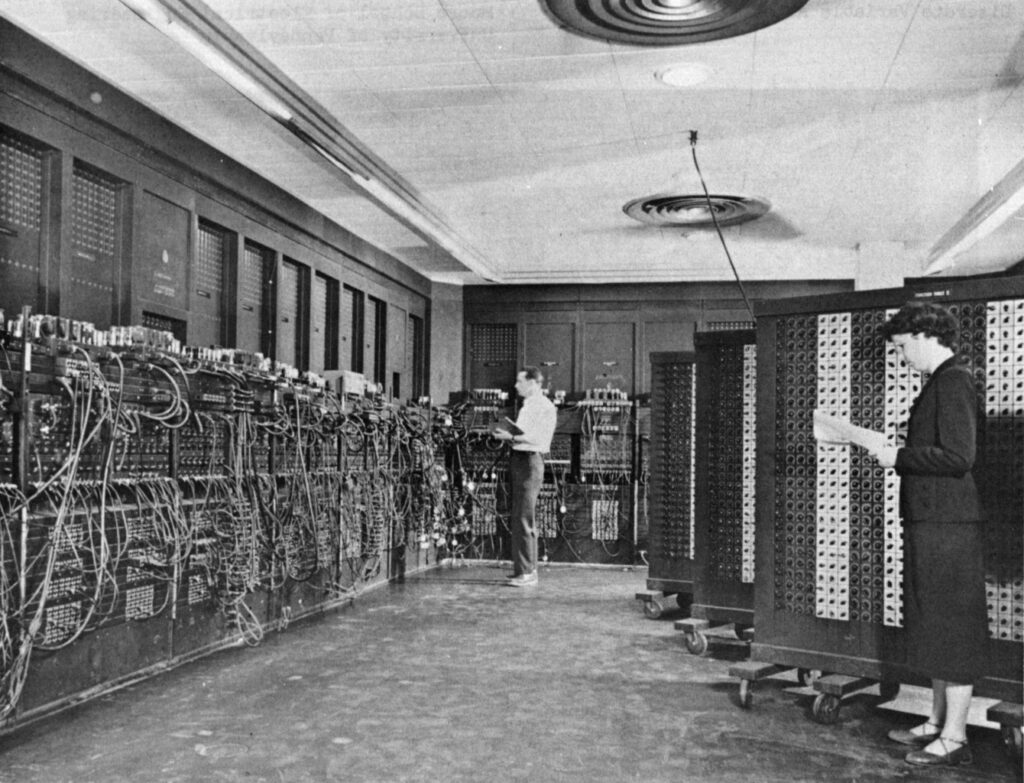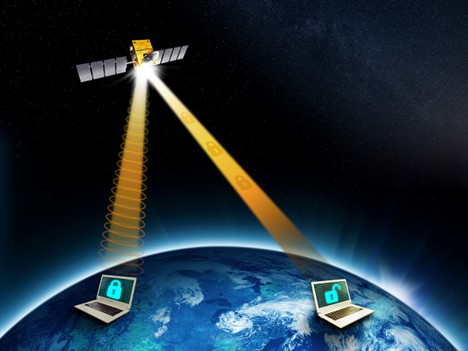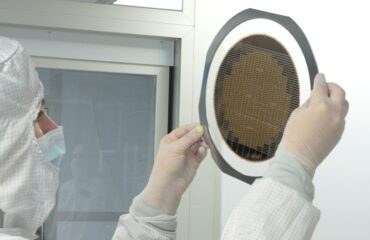
Dr. Maika Takata in IBM’s quantum computer lab. Image: IBM
By James Myers
A high-stakes international race is on to develop a quantum computer that operates either error-free or with a very low error rate, allowing the machine’s computational speed and accuracy to be put to use in practical applications with algorithms now under development.
Here, we survey some of the recent developments indicating that quantum computing is poised to exit its infancy within only a few years, and we’ll explore some of the applications now under development.
Companies and governments are vying to be the first to develop a fully functional machine, with reports that China is significantly outspending its Western rivals to gain a major advantage. Recognizing the threat to its national security, the U.S. government has launched a major initiative to take the lead in emerging technology, and other countries in the G7 are following suit.
Nobody wants to be left behind with a technology that promises to revolutionize computing, and which is quickly advancing from theory to reality. Early-stage quantum computers with limited capabilities are already being used for the development of life-saving medicines, logistics optimization, fuel-saving aircraft design, and investigation of potential new materials for industrial use.

Computing has advanced far beyond the earliest machines. The ground-breaking ENIAC (Electronic Numerical Integrator and Computer), is shown in this photo from 1947. Image: Wikipedia.
Will error-free quantum computing arrive within five years?
Quantinuum is the world’s largest integrated quantum company, formed in 2014 when the quantum division of U.S.-based Honeywell merged with U.K.-based Cambridge Quantum. This April, the company announced that its machine was the first to achieve a quantum volume exceeding 1,000,000, to 1,048,578 which is equal to 2 raised to the 20th power. Quantum volume is a key industry measure of performance and error rate, indicating the number of square circuits successfully implemented.
For contrast, as recently as January 2020 IBM led in quantum volume, at a level of 32 which is equal to 2 raised to the 5th power. The exponential growth in volume over the last four years is clear to see.

In September, Quantinuum’s Chief Scientist for Algorithms and Innovation Dr. Harry Buhrman, and Fellow Dr. Chris Langer, announced that within five years the company “will deliver a fully fault-tolerant and universal quantum computer capable of executing millions of operations on hundreds of logical qubits.”
A qubit is the unit of information in the quantum computer, analogous to the bit in binary computers now used worldwide. There are several different methods for creating physical qubits, and logical qubits are created when physical qubits are connected in an operational circuit. Until recently, it had been thought that 1,000 physical qubits would be required to create one logical qubit, however in early 2024 Microsoft and Quantinuum announced a system that produces a far more efficient yield of 4 logical qubits from just 30 physical qubits.

Diagram of a quantum circuit, with each horizontal line registering one qubit. The top line is the qubit register labelled 0, the second line is a qubit register labelled 1, and so on with successive lines. The square boxes are gates that act on qubits; the black circle represents the control qubit, and the cross within a circle represents the target qubit, with the meter symbol (e.g. labelled “4”) representing a measurement. Image: Microsoft Learn.
Quantinuum’s fifth-generation system under development, called Quantinuum Apollo, is scheduled for service in 2029. The machine is expected to operate with thousands of physical qubits, creating hundreds of logical qubits and resulting in a physical error rate of less than 1/10,000.
Qubits are susceptible to errors caused by interference from electromagnetism, heat, and other environmental factors. To date, the primary challenge in developing a quantum computer for practical applications has been the battle against decoherence, which is the tendency of qubits to lose their connections from environmental disturbance.

The 156 qubits on IBM’s Heron chip provide for “real-time classical communication between processors” and offer “up to five-fold improvement in error reduction” over IBM’s earlier Quantum Eagle chip. Image: IBM.
Until recently, Quantinuum rival IBM held the record for the number of qubits in a quantum computer with its 433-qubit machine named Osprey. Late last year, startup Atom Computing announced the introduction of a 1,180-qubit machine, and has partnered with Microsoft “to ultimately build the world’s most powerful quantum machine.” The number of qubits is not the only measure of a quantum computer’s capability, and by 2029, IBM expects its improved quantum circuitry will provide 100 million gates capable of sustaining a major computational workload.
Quantinuum’s announcement indicates that the company is continuing development of error correction codes that could reduce the error rate of Quantinuum Apollo to much lower than 1/1,000,000 and possibly even to 1/10,000,000, which is a level the company says will enable “exploration of even more complex problems of both industrial and scientific interest.”
Which quantum computing architecture will prove best?
Quantinuum’s machines store a qubit’s information in the atomic states of a single ion, and qubits are guided by laser beams to perform operations. Qubits are held in place using electromagnetic fields and are moved by changing electrical voltages applied to the chip. Other machines are designed differently; for example, the qubits in Atom Computing’s machine consist of arrays of electrically neutral atoms of alkaline-earth metals that are trapped and controlled by lasers.

Xanadu’s Toronto lab. Image: Xanadu
Photonics is another promising method for creating stable qubits using light, with the advantage of operating at room temperature when other quantum architectures require supercooling to reduce interference. Xanadu, a Toronto-based quantum computing company, uses photonics to produce qubits based on the quantum states of light.
 The company states that its optical networking is capable of scaling to one million qubits operating with four components, the first of which replaces quantum gates with light measurements. The next three components connect the qubits with beamsplitters and use optical switches to route successful connections to a final phase where a laser is used to count photons, which are light particles. If the counting reveals a specific pattern of photons, it indicates that a qubit has been successfully created.
The company states that its optical networking is capable of scaling to one million qubits operating with four components, the first of which replaces quantum gates with light measurements. The next three components connect the qubits with beamsplitters and use optical switches to route successful connections to a final phase where a laser is used to count photons, which are light particles. If the counting reveals a specific pattern of photons, it indicates that a qubit has been successfully created.
A study published in September in Nature Photonics advances the potential to create multiple qubits on a single photon of light using a process of “high-dimensional spatial encoding.” The researchers, Ohan Lib and Yaron Bromberg, demonstrated that creating single-photon clusters of nine qubits substantially reduces computation time, and therefore errors that accumulate over time.

Quantum computing company D-Wave uses a different approach to quantum computing, called annealing, which it states is “unequivocally” best suited for optimization problems. D-Wave’s whitepaper explains annealing as a process in which, “Given a problem with objective function f (x), the control system drives all qubits simultaneously, through a smooth transition (called an anneal) from an initial random state to one that matches the objective, so that the qubits finish in states x corresponding to optimal and near-optimal solutions to f (x).”
The term “quantum annealing” was coined in 1988 to describe an optimization process for finding the smallest possible value of a function that represents its optimal state with the least variability. D-Wave announced that its Advantage 2 system (pdf available), expected this year, will enable 20-way connectivity between more than 7,000 qubits.
What’s on the horizon for quantum computing and how could it affect us in the near-term?
In September, global bank HSBC announced that the successful completion of a test quantum-secure technology for buying and selling tokenized physical gold. In 2023, the bank offered gold tokens, representing fractional ownership of physical gold, to institutional clients and in 2024 expanded the offering to retail clients in Hong Kong. The test was conducted in collaboration with Quantinuum.
The buying and selling of gold tokens is an example of the future applications of quantum computing in finance, which are discussed in TQR’s feature article Quantum Computing in Finance: Will Humans or Machines Have the Final Say in Setting Future Values?
Large language models applications like OpenAI’s ChatGPT and Google’s Gemini have come into widespread use since the technology was introduced two years ago, but their shortcomings including biases, ‘hallucinations,’ and outdated data have proven controversial. Quantinuum is developing methods to improve the reliability of these systems using quantum computers. The company states, “The primary problem with LLMs is that nobody knows how they work – as inscrutable “black boxes” they aren’t “interpretable”, meaning we can’t reliably or efficiently control or predict their behavior.”


Notice on the OpenAI website, maker of ChatGPT, dated May 21, 2024.
The term “hallucination” no longer appears on OpenAI’s site, which this January contained a warning about GPT-4 that read as follows: “GPT-4 still has many known limitations that we are working to address, such as social biases, hallucinations, and adversarial prompts.” The hallucination warning was featured in The Quantum Record’s editorial AI and Critical Thinking: A Difficult Mix We Need to Get Right.
To provide a better measure of successful interpretation by LLMs of complex stories, Quantinuum uses what it calls “compositional generalization,” explaining that “this means we train small, on classical computers, and then at test time evaluate much larger examples on a quantum computer.” The company provides a detailed explanation and examples of how its quantum circuits can deliver a measure of the accuracy of a ChatGPT output involving the actions of eight humans, and possibly as many as thirty.

Today’s homes contain many interconnected devices in the “Internet of Things.” Image: Pete Linforth.
With the proliferation of internet-connected “smart” devices for home and industrial control, making ageing electrical grids resistant to cyber attacks is a pressing global issue. Xanadu is part of a group researching the use of quantum technologies to “explore customized post-quantum cryptography and communication solutions for modern smart grids and similar industrial control infrastructures.”
At a time when great amounts of sensitive data are exposed to hackers and criminals, a significant research focus is being placed on securing quantum communications. One new potentially secure method to hide communications from eavesdroppers encodes data in the spaces between photons of light. Phys.org reports that using the properties of quantum optics, researchers at the Paris Institute of Nanoscience at Sorbonne University have developed a method to encode images in the spatial connections between entangled photons of light at potentially great distances. The encoding is invisible to conventional cameras that capture differences in light to record images. To a camera, the light appears with a uniform distribution and leaves no trace of the image, but with information on the spatial encoding, the image can be reconstructed.

Quantum Key Distribution (QKD) is expected to provide secure space-based quantum communication. Image: Canadian Space Agency.
Canada is planning to launch a quantum satellite in 2025. Called Quantum EncrYption and Science Satellite (QEYSSat), its mission will be to demonstrate secure ground-to-space quantum communication using quantum key decryption (QKD). The Canadian Space Agency explains, “QKD is a technology that creates virtually unbreakable encryption codes and will provide Canada with secure communications in the age of quantum computing. QEYSSat will bring Canada a step closer to the realization of a truly secure communication infrastructure that will enable national and even global interconnection.” QKD uses photons to generate a random decryption key shared between two parties and can detect the presence of any third party trying to intercept the key.
Preparing for a quantum future is an increasingly urgent priority.
As recently as a year ago, there was a consensus in the technology world that quantum computing would not be viable for perhaps a decade.
The advancing expectations of companies like Quantinuum, Microsoft, IBM, Atom Computing, D-Wave, and others for large-scale fault-tolerant quantum computing by the end of this decade – only little more than five years away – calls for a re-evaluation of priorities and planning.
While we described some of the directions that quantum computing is heading for, we have also highlighted in our ongoing series on quantum ethics the unresolved questions surrounding the potential uses of the powerful technology. As we stated in May when we launched our quantum ethics series, “There’s no time like the present to plan for the human future with quantum technology.”
Craving more information? Check out these recommended TQR articles:
- The Genius of Alan Turing, and the Technology that Cracked the Nazi Enigma Code
- What Will a Recent Quantum Leap in Time Crystal Technology Reveal About the Elusive Nature of Time?
- Editing Our Human Selves: Will Quantum Computing’s Potential Increase the Risks or the Benefits?
- The Incredible Power of Shape: Fractals Connect Quantum Computers to the Human Body and the Cosmos
Join our community of readers shaping the future of The Quantum Record. Share your thoughts in just 2 minutes!
☞ Click here to complete our 2-minute survey




